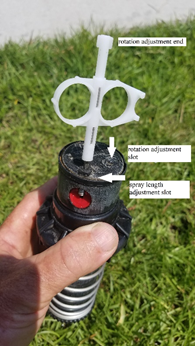By Pat Naughton
Applying the right amount of water in the correct locations is key to saving money and having a green lawn. Watering a typical 5000 sg ft yard with a half inch of water uses 1,558 gallons of water. Which costs close to $5 each time.
According to NC State Extension TurfFiles website, lawn grasses of Bermudagrass, Centipede, and St. Augustine, need one inch of water a week. Zoysiagrass needs 1 ¼ inch of water a week. On sandy soils it is recommended to water ½ inch every third day for all these grasses.
To determine what each section of the lawn is receiving from the spray, place an empty short can, about the size of a tuna can on the lawn. After an irrigation cycle check the water depth and adjust the timer and spray accordingly to achieve a half inch of water per watering.
The typical irrigation head can be adjusted for start point, finish point, and spray length. To change the starting point, unscrew the head from the canister. Find the center cap on the rotor case. Move it all the way to the right until it stops, and you can no longer turn it. Then, move it to the left until it stops. This is the starting point. Keeping the arrow aimed at the starting point, insert the head in the canister and tighten the top of the head.
To adjust the finish point you will need an adjustment key, which are available at major hardware stores. Insert the plastic end of the key in the rotation slot marked with “+” and “–“ directions. Turn the key to the + direction to increase the arc and to the – to reduce the direction.
The final adjustment is the spray length. This is adjusted by inserting the metal end of the key above the nozzle. There is a screw which interferes with the spray to change the length. Turning the screw in will decrease the length.
The best time to water your lawn is in the early morning hours, between 3 a.m. and 7 a.m., when temperatures are cooler and the evaporation rate is low. Avoid watering between 9 p.m. and 1 a.m. Watering at these times can extend the leaf wetness period created by dew, which can increase disease problems such as gray leaf spot.
Learn More!
For more information about lawn care, visit http://ces.ncsu.edu, where you can post your questions via the ‘Ask an Expert’ link, http://www.turffiles.ncsu.edu, or contact the Brunswick County Extension office, 253-2610.


